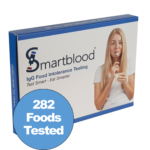On 1 October 2021, a new law on allergen labelling came into effect. From this date, any food business selling pre-packaged foods for direct sale (PPDS) must include full ingredient details on the label, with allergenic ingredients highlighted.
The rule, known as ‘Natasha’s Law’, follows the death of teenager Natasha Ednan-Laperouse, who suffered a fatal allergic reaction to the sesame baked into a pre-packaged baguette from chain café Pret which, at that time, did not require allergen labelling.
It’s a positive step for the two million people living with a diagnosed food allergy in the UK, as well as those with food intolerances and food sensitivities, such as coeliac disease.
Avoiding trigger foods when choosing meal options on the go can be stressful, so the new ruling is potentially a very welcome change. So, what will Natasha’s Law look like in practice?
What does Natasha’s Law mean for businesses?
From the beginning of October, any food business which sells pre-packaged foods will have to include a full list of ingredients on the packaging, making any allergens in that list clear.
These changes will impact a wide range of businesses, such as bakeries, caterers, fast food outlets, takeaways, mobile sellers, restaurants, cafés, pubs and even schools.
What types of food does the law cover?
The law looks to be quite broad. As an example, prepacked for direct sale food can include the following:
- Burgers and sausages pre-packaged by a butcher on the premises ready to sell
- Fast food packed before it is ordered, such as a burger under a heat lamp
- Foods packaged and then sold elsewhere by the same operator, such as a market stall
- PPDS food provided in schools, care homes or hospitals and other similar settings
- Products pre-packaged on site ready for sale, such as pizzas, salads, and pasta pots
- Samples of cookies given to consumers for free which were packed on site
- Sandwiches and bakery products packed on site before a customer selects them
What needs to be on the label?
From October onwards, labels on pre-packaged food must show the name of the food and the ingredients list, highlighting any allergens from a list of 14 which are required to be highlighted by law.
Consumers may be allergic or have an intolerance to other ingredients, but only the 14 allergens are required to be declared as allergens by food law.
These allergens are:
- celery
- cereals containing gluten(such as barley and oats)
- crustaceans(such as prawns, crabs and lobsters)
- eggs
- fish
- lupin
- milk
- molluscs(such as mussels and oysters)
- mustard
- peanuts
- sesame
- soybeans
- sulphur dioxide and sulphites(if they are at a concentration of more than ten parts per million)
- tree nuts(such as almonds, hazelnuts, walnuts, brazil nuts, cashews, pecans, pistachios and macadamia nuts).
Allergy or Intolerance?
While Natasha’s Law has been brought in to help mitigate the risks of exposure to potential allergens, which can be fatal, the new law will also be helpful for those who suffer with food intolerances.
Food allergy and intolerance are terms which are frequently interchanged, but it’s important to understand the differences. While the biological processes involved in both food allergies and intolerances might seem similar, with the body reacting in response to a perceived threat, they involve different antibodies that trigger specific reactions.
Food allergies involve an immune response. When a person with an allergy consumes an ingredient it identifies as an allergen, the body overreacts, producing antibodies called immunoglobulin E (IgE). These IgE antibodies travel to cells that release chemicals, causing an allergic reaction. The reaction is usually fairly instant and presents in severe symptoms, like a rash, breathing difficulties or anaphylaxis.
Food intolerances are much less severe. The process is similar, with the body releasing immunoglobulin G (IgG) antibodies, but the reaction time is usually slower and the symptoms, although often uncomfortable and frustrating, are not life-threatening.
Testing options for allergy and intolerance
Testing options for food intolerance and food allergy are quite different.
If you are concerned that you have a food allergy, it is possible to get tested through the NHS. After a consultation to explore your symptoms, your GP may refer you to an allergy clinic for a test. Options include a skin prick test or a blood test.
Currently, the NHS do not offer a test for food intolerance. There are many private options you can explore but it’s important to do your research. Not all types of food intolerance test will give you a clear and accurate result and there are a lot of options available on the market, such as Vega, kinesiology and hair analysis, which have no proven basis in science.
The traditional ‘gold standard’ used to detect food intolerance is an elimination diet. This is a painstaking process that involves removing one food from your diet at a time, for a few weeks per ingredient, and tracking how you feel. With food intolerance sufferers reacting, on average, to between 4-6 ingredients, it can take a long time before you have a complete picture of your trigger foods. It’s not uncommon for people to stop the elimination diet before all trigger foods have been found, thinking they have cracked the problem after finding just one of the ingredients.
Get answers faster
At Smartblood, we offer a comprehensive test to help you take control of your diet quickly. Our home-to-laboratory service, using ELISA plate testing, gives you fast, accurate results that pinpoint exactly which foods you are reacting to. Tests are completed in our accredited laboratory by trained experts, with clear, accurate results delivered to you via email within three days. The test is supported by a 30-minute consultation with our BANT registered Nutritional Therapist to help you understand your results and make safe, sustainable changes to your diet.




